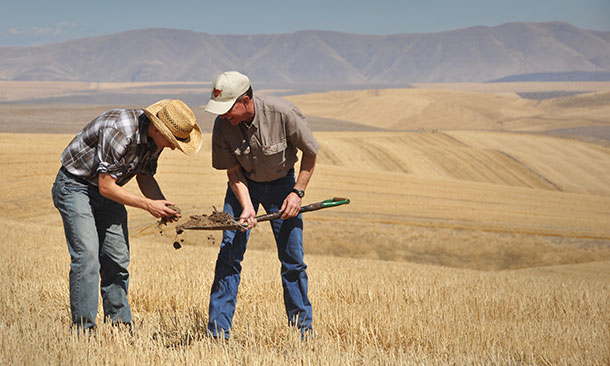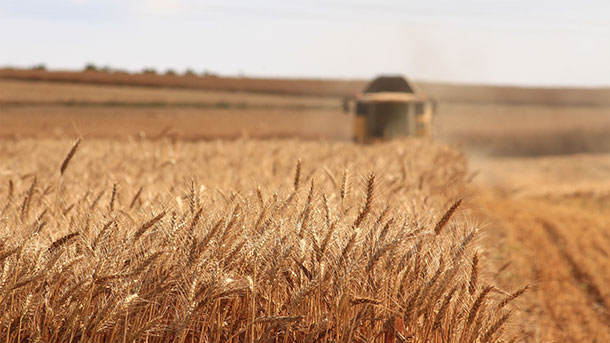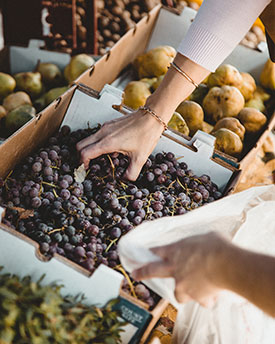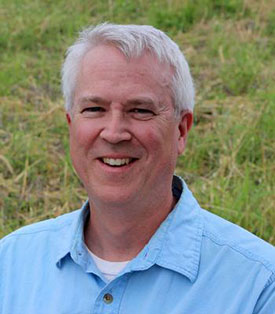Farm Bills Tough on Conservation and Food Stamps
Air Date: Week of June 29, 2018

Conservation programs under the farm bill provide funding for farmers to plant cover crops and maintain soil health. Above, two soil conservationists examine a soil sample on a farm in Oregon. (Photo: U.S. Department of Agriculture, Flickr, CC BY 2.0)
Both House and Senate versions of the 2018 farm legislations would reduce resources for conservation measures, and the Republican House wants to make it harder for people to get food stamps. At stake is more than $660 billion federal dollars and a variety of programs that also include trade, rural development, crop supports and loan programs. Ben Lilliston of the Institute for Agriculture and Trade speaks with Host Steve Curwood.
Transcript
CHRISTIANSEN: From PRI and the Jennifer and Ted Stanley studios at the University of Massachusetts Boston, this is Living on Earth. I’m Savannah Christiansen.
CURWOOD: And I’m Steve Curwood. Every five years, Congress looks to revise comprehensive farm legislation. And so far the different versions of the bills passed by the House and Senate both call for cuts in conservation programs and the Republican-only House measure would also tighten eligibility for food stamps. Food stamps under the Supplemental Nutrition Assistance Program or SNAP, will cost about 80 percent of the 450 billion federal dollars at stake. The rest will feed programs like crop subsidies, trade and bioenergy. We turn now to Ben Lilliston of the Institute for Agriculture and Trade Policy. Welcome to Living on Earth, Ben!
LILLISTON: Thanks for having me.
CURWOOD: So, your organization has criticized the concept that the farm bill assumes that farmers will lose money. Why the assumption that farmers will lose money?
LILLISTON: Well, farmers in most years actually produce much more than the market will bear, and the farm bill sort of incentivizes that. It really puts in a number of programs that tell farmers to grow certain kinds of commodity crops, about five different types of commodity crops and then the bankers follow that lead and will give farmers loans for those. And so you see us overproduce corn, soybeans, wheat in many years and a signal of that is that the prices will go down below the cost of production for the farmer, and then the farm bill, what it does is make up that difference and try to help farmers stay on the land keep farming when the market price sinks below the cost. And so it's a kind of perverse system of overproduction that is just kind of accepted within the farm bill that we need to have robust programs to help farmers out when things go south in terms of making enough money to keep going.

The farm bill incentivizes overproduction of commodity grains like corn and wheat, so those grains can be exported to the international markets. (Photo: Meriç Tuna, Unsplash, Creative Commons)
CURWOOD: So, I'm quite puzzled by all of this. Farmers overproducing in a relatively hungry world? And I gather the legislation is oriented towards farmers exporting their crops abroad and yet we're told local produce, fresh and healthy, is what's better for us. What about us at home? I mean I think we all eat, don't we?
LILLISTON: We do. Yeah, and that's another I think problem, structural problem, with the farm bill. It really is focused on exports and producing way more than the US can use and then exporting it around the world and also producing a lot of animal feed to continue to produce massive amounts of whether it's pork or poultry or beef, and then export that into the world. At the same time farmers who are really interested in producing locally and for accessing local markets often have trouble accessing land or getting access to farmland and so the infrastructure is not there. So, the farm bill really kind of works against that.
CURWOOD: Sounds like it's back in the, what, days of the depression or something when it was a much different America.
LILLISTON: Yeah, it was a much different America, and there's a reason why those commodity programs are in place. You know at one time we were concerned about producing enough food, and those programs also at that time included things that ensured a fair price for farmers so they didn't feel all the pressure to overproduce. And there were also conservation requirements to participate in those programs, so it was right after the dust bowl. So, they were required to deal with soil health at that time and things have changed over the years. And really the main driver changing it has been global agribusiness companies. They've been wanting access to cheap grain, to cheap commodities that they can export and make money off of, and farmers have sort of been viewed as expendable. And we've seen a steady concentration in ownership of farmland, so there's fewer farmers out there but more big, really huge mega farms.

Most of the funding for the farm bill goes toward the Supplemental Nutrition Assistance Program (SNAP), otherwise known as food stamps, which also helps spur growth in local economies. (Photo: Dane Deaner, Unsplash, creative commons)
CURWOOD: Ben, tell us what's covered in the farm bill that should be of special concern to people who are concerned about the environment, ecology, climate change? What's in the bill and why do those provisions matter?
LILLISTON: Yeah, one of the significant sections of the farm bill are the conservation programs, and there's several different types. One type is the conservation reserve program. It takes farmland that's marginal that maybe shouldn't be farming and takes it out of production and protects it for wildlife, natural habitat. So, that's a very important part of the program. And then the other two kind of big programs are what are called Working Lands programs, and they support conservation practices for farmers. One’s the Conservation Stewardship Program, and the other is called EQIP, the Environmental Quality Incentives Program. So, those programs help support farmers who want practices that protect soil health or enhance soil health, protect water quality, reduce emissions, are able to withstand more extreme weather that we're seeing with climate change. They're really popular programs. I mean, they can only really fund around half of the participants that try to get access to these programs, and I think what is concerning is that in this farm bill in the House they're eliminating the Conservation Stewardship program and then making the overall cuts as well to conservation programs and even in the Senate farm bill there are still significant cuts to conservation programs, and so we're kind of going in the opposite direction that we really need to in terms of helping farmers respond to climate change.
CURWOOD: What you're telling me is that regardless of what the Congress finally does about the farm bill this time around, you don't see progress in terms of environmental stewardship. Why is that?
LILLISTON: Well, we have a fundamental problem in that the farm bill is really led by Ag Committee chairs in both the Senate and House who are climate deniers. And so when you don't acknowledge that climate change is happening and that you need to respond to it and that needs to be part of really your service to farmers -- your responsibility as members of Congress to farmers -- then you write a farm bill as if climate change is not happening, as if we don't need to make these kind of changes, and that, as if things are going on in the same way that they always have. And that's a real problem, it's a real blind spot I think for Congress and a real blind spot in this farm bill.
CURWOOD: So, how is climate change affecting agriculture right now and vice versa, how is agriculture contributing to climate change?
LILLISTON: Yeah, agriculture sits in a really unique space in climate change because, on the one hand, farmers are experiencing extreme weather very directly. Just in the last year, I mean both of the major hurricanes that hit the US also hit farmers. But then you also had a fairly severe drought in the upper Midwest followed by wildfires. So, we're seeing more wildfires than we ever have, and you're also seeing that in this year in sort of the southern part of the United States in the southwest. So, they're dealing with extreme heat, drought, extreme weather events where there are heavy downpours and we've seen that a lot in the upper Midwest, which can wipe out crops very quickly. But you're also seeing pests move north that had never been there before, weeds move into cropping systems that hadn't been there before. So, there's a lot of change happening directly to farmers right now, and they're trying to deal with that. And then the other element of agriculture, of course, is that it contributes to climate change, and some of the major emissions come from heavy fertilizer use, synthetic fertilizer use, which emits nitrous oxide, a greenhouse gas, and then methane emissions from livestock production. And then the third area that agriculture intersects with climate change is that it can actually sequester carbon. And so perennial crops, cover crops, sustainable grazing on farm can all help sequester carbon from the atmosphere. So it's a really unique intersection when compared to other sectors and climate change.
CURWOOD: Now, some would say that we're currently in a farm crisis. What is that crisis and what's driving it?

Ben Lilliston is Director of Rural Strategies and Climate Change at the Institute for Agriculture and Trade Policy. (Photo: Institute for Agriculture and Trade Policy, IATP)
LILLISTON: Yeah, so we've had over four years straight of really low farm income. As I mentioned before, many times below-cost of production prices for farmers and there's a number of things driving this. Some of it is we're producing a lot of commodity crops. Other countries in the world are also producing a lot of commodity crops, so Brazil and Argentina; Australia. So, there's a global glut of overproduction and then now, we're seeing trade disruptions related to the Trump administration who's picking a lot of fights and many of these fights are with our major agricultural trade partners -- so China, Mexico, Canada, Japan, the European Union -- all countries that he's picked fights with. And so, that's affecting agriculture markets as well, driving prices down. The dairy industry is a little bit separate, and that is again an over production issue where we've brought online a number of major mega dairies over the last five years, and they are way out-producing what the domestic demand is, and that's causing a very severe crisis among dairy farmers in the US.
CURWOOD: OK, Ben, if you were in charge of the farm bill right now, the House and Senate Ag chairman come to you and they say, please, write this bill for us when it comes to climate. What would you put in it?
LILLISTON: Well, first we would need to really boost conservation funding and in a major way. I think every farmer who wants to access these conservation programs should be able to access them. We need to integrate climate concerns in the crop insurance program. So, crop insurance has become a major part of the farm bill, but right now it doesn't reward farmers for being more resilient. Just as in your home, if you do certain things, have a fire extinguisher and so forth, you'll get benefits in your homeowner's insurance. Farmers should have that same kind of incentives built into crop insurance around climate resilience, and we used to have some production limits in our farm programs to really address the overproduction of these commodity crops. They shouldn't be on marginal farmland. And so how can we put in programs that ensure farmers are paid fairly, but doesn't incentivize overproduction.
CURWOOD: So, Ben, what if anything is unique about this year's proposals for the farm bill?
LILLISTON: Yeah, well for the first time the House passed the farm bill, but it was entirely partisan. So, I think that's really unique in that usually there is bipartisan support at some level to get it through either house of the Congress. Here you had every Democrat oppose that farm bill and it barely passed. In the Senate they have more of a bipartisan approach, but the divisions between the Senate and the House on this farm bill are considerable, and it will be very interesting to see if they can come together with a compromise that can pass both houses. Last farm bill they really struggled to get it passed. They had to extend it two years to keep it going until they could find a compromise and again it was a lot of backroom dealing that actually kind of powered it through. So, what you're seeing is as we have fewer and fewer rural legislators, fewer and fewer members of Congress that are tied closely to farm communities, you're also seeing more and more difficulty in passing a farm bill, and getting other members of Congress to say hey these programs make sense. You have a hard push from very conservative fiscal conservatives to eliminate a lot of farm bill programs both for farmers and in the SNAP program, the nutrition title. And then you have farm representatives, some farm senators really trying to keep those programs. You have the environmental community saying we need to step up on these conservation programs. The health community has weighed in. Rural development people weighed in. So it’s a complicated mix of constituencies. And it’s really creating a little bit of a political fight in this farm bill, and I think we’ll see that going forward in future farm bills.
CURWOOD: Ben Lilliston is Director of Rural Strategies and Climate Change at the Institute for Agriculture and Trade Policy based in Minneapolis. Thanks Ben for taking the time with us today.
LILLISTON: Oh, thank you.
Links
The Institute for Agriculture and Trade Policy
Ben Lilliston, The Institute for Agriculture and Trade Policy
Living on Earth wants to hear from you!
Living on Earth
62 Calef Highway, Suite 212
Lee, NH 03861
Telephone: 617-287-4121
E-mail: comments@loe.org
Newsletter [Click here]
Donate to Living on Earth!
Living on Earth is an independent media program and relies entirely on contributions from listeners and institutions supporting public service. Please donate now to preserve an independent environmental voice.
NewsletterLiving on Earth offers a weekly delivery of the show's rundown to your mailbox. Sign up for our newsletter today!
 Sailors For The Sea: Be the change you want to sea.
Sailors For The Sea: Be the change you want to sea.
 The Grantham Foundation for the Protection of the Environment: Committed to protecting and improving the health of the global environment.
The Grantham Foundation for the Protection of the Environment: Committed to protecting and improving the health of the global environment.
 Contribute to Living on Earth and receive, as our gift to you, an archival print of one of Mark Seth Lender's extraordinary wildlife photographs. Follow the link to see Mark's current collection of photographs.
Contribute to Living on Earth and receive, as our gift to you, an archival print of one of Mark Seth Lender's extraordinary wildlife photographs. Follow the link to see Mark's current collection of photographs.
 Buy a signed copy of Mark Seth Lender's book Smeagull the Seagull & support Living on Earth
Buy a signed copy of Mark Seth Lender's book Smeagull the Seagull & support Living on Earth

